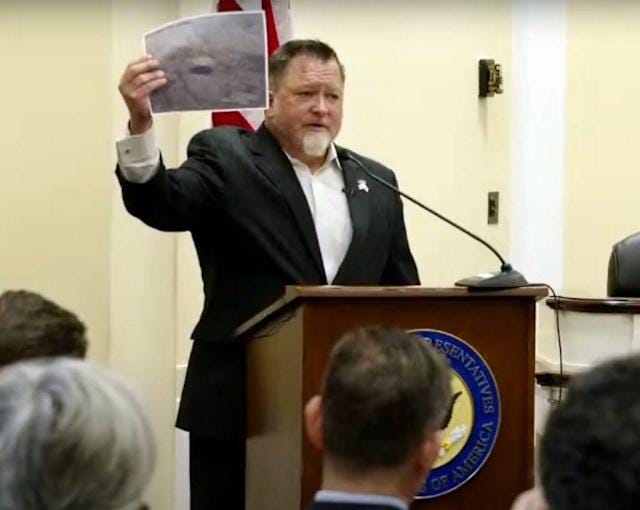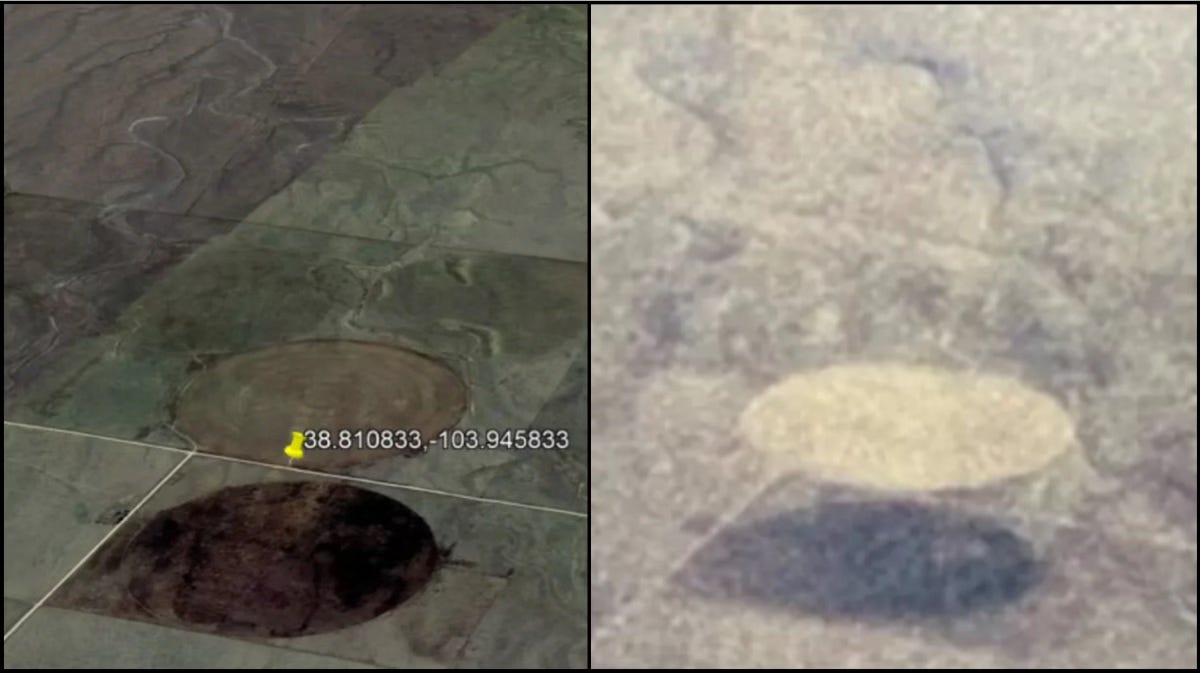The UFO Panel That May Have Broken the Narrative
What a former physicist said in front of a Congressman—and why it could unravel the whole disclosure movement.
When the Curtain Lifted—And the Script Slipped
In movements built on mystery, credibility is everything. But just like a UFO, it can vanish in a flash—leaving only questions in its wake.
Over the past decade, “UAP disclosure” has shifted from fringe theory to congressional concern. Once relegated to whispers and grainy footage, the phenomenon has drawn defense insiders, whistleblowers, scientists, and lawmakers into its orbit. The stakes have never felt higher: are we confirming the presence of non-human intelligence, or witnessing the most elaborate psychological operation of the 21st century?
On April 22, 2025, in a modest conference room in Washington, D.C., a panel convened under the banner Understanding UAP Science, hosted by the UAP Disclosure Fund. With former Pentagon officials, physicists, and members of Congress in attendance, the event was pitched as a milestone in transparency.
Instead, it became something else: a glimpse behind the curtain. Not a revelation, but a reveal—a moment when the machinery of modern disclosure briefly flickered into view.
UAP Disclosure: A Quick Primer
Since 2017, “UAP disclosure” has referred to the gradual release of government documents, whistleblower testimonies, and military footage suggesting contact with unidentified aerial phenomena—what many still call UFOs. Once mocked, the topic has steadily gained institutional traction. Advocates see a paradigm shift. Critics see smoke and mirrors, orchestrated by a tightly connected group of repeat figures.
The Photo That Cracked the Frame
Luis “Lue” Elizondo, former head of the Pentagon’s Advanced Aerospace Threat Identification Program (AATIP), served as moderator. He’s long been regarded as a whistleblower who helped make military UAP videos public.
Midway through the panel, he presented a photograph, supposedly passed to him by a private pilot. At first glance, it seemed explosive: a gleaming saucer hovering above the Earth, casting a distinct shadow. It was dramatic, visceral—precisely the kind of evidence believers had hoped for.
But within hours, researchers including those at Metabunk identified it as a standard agricultural irrigation circle, visible on satellite imagery in the Four Corners region. It wasn’t new. It wasn’t mysterious. And it wasn’t anomalous.
For those already skeptical, this wasn’t just a mistake—it was a red flag. Dr. Sean Kirkpatrick, the former director of the Pentagon’s All-domain Anomaly Resolution Office (AARO), has criticized the disclosure movement for its reliance on recycled evidence and circular reporting. This moment gave weight to that critique.
A Backlash—and an Even Bigger Bombshell
Online reaction was swift and unforgiving. Across platforms like Reddit’s r/UFOs, frustration turned to suspicion. Why present unverified material at such a high-profile event? Was this a misstep—or a calculated misdirection?
Then came the real shock: a claim made by physicist Dr. Eric Davis.
Grusch, Davis, and the Deepening Divide
To understand why Davis’s words mattered, one had to revisit the testimony of David Grusch.
In July 2023, Grusch—an Air Force veteran and intelligence officer—testified under oath before Congress. He alleged that the U.S. government had for decades operated secret crash retrieval and reverse engineering programs involving non-human craft, shielded by labyrinthine contracting and special access protocols.
Among the 40 witnesses Grusch interviewed as part of his inquiry, one name stood out: Dr. Eric Davis.
Davis isn’t an outsider. He’s a physicist who worked for EarthTech, held a research role with Bigelow Aerospace Advanced Space Studies (BAASS), authored classified reports for the Defense Intelligence Agency, and was closely aligned with key figures in the UAP ecosystem.
His presence on the panel was no coincidence.
The Moment Everything Tilted
When Congressman Eric Burlison asked Davis to describe the beings allegedly associated with recovered craft, the physicist didn’t blink.
“Grays. Reptilian-types. Insectoid-types. Nordics.”
You could feel the air shift.
These weren’t vague terms. They were the archetypes of UFO lore—the very images that populate abduction accounts and decades of conspiracy. And they had just been declared as fact, by a credentialed physicist, to a sitting member of Congress.
Davis wasn’t under oath. But Burlison was present. The statement is now part of the congressional record. Whether challenged or ignored, it cannot be unseen.
If Davis is telling the truth, the implications are seismic. If he isn’t, the credibility of Grusch—and perhaps the broader disclosure movement—could collapse under the weight of its most extreme claims.
The Core Network Behind Disclosure
None of these events occurred in isolation.
Nearly every figure at the center of UAP disclosure connects back to three individuals:
Hal Puthoff – Former NSA physicist, architect of the CIA’s Stargate remote viewing program, and chief scientist at To The Stars Academy. He mentored Davis and has long served as a bridge between fringe science and classified research.
James Lacatski – DIA rocket scientist who created the AAWSAP program with $22 million in Senate-approved funding. He recruited Elizondo and co-authored Skinwalkers at the Pentagon.
Jay Stratton – Director of the UAP Task Force, and the only official known to have worked across AAWSAP, AATIP, and UAPTF. He mentored Grusch and shaped much of the internal reporting structure behind the modern narrative.
And behind them all, often in shadow, is Robert Bigelow—the billionaire who bankrolled Skinwalker Ranch investigations, founded BAASS, and made substantial political donations to GOP candidates including Donald Trump. His funding has consistently fueled the research, relationships, and media narratives sustaining UAP disclosure.
Elizondo? Brought in by Lacatski. Operated under Stratton. Worked beside Puthoff.
Davis? Trained by Puthoff. Funded by Bigelow. Worked for AAWSAP.
Grusch? Worked under Stratton. Relied on Davis.
This isn’t a spontaneous grassroots awakening. It’s a closed loop—curated, sustained, and endlessly recirculated.
If This Is a Script, Who’s Writing It?
The April panel was meant to be a moment of clarity. Instead, it revealed the scaffolding of something far more curated.
The evidence? Weak. The claims? Familiar. The cast? Repetitive.
The question isn’t just what we’re being shown. It’s why we’re being shown it—again and again.
What if the momentum behind UAP disclosure since 2017 hasn’t been organic? What if it’s an operation—a narrative engineered for objectives we don’t yet fully understand?
Is it a slow release of inconvenient truths, or a controlled demolition of institutional trust? Is it a foreign psy-op meant to make U.S. agencies appear absurd? Or a domestic one, designed to sideline legacy defense contractors and usher in a new class of technocratic stakeholders?
Are we watching a quiet coup, replacing one deep state with another under the banner of transparency? Or are we trapped in a self-reinforcing mythos driven by social capital, media cycles, and the allure of forbidden knowledge?
And if this is an operation, where did it begin? With AAWSAP in 2008, when Bigelow’s BAASS won the DIA contract to investigate anomalies? Or earlier—after Project Blue Book closed, when intelligence agencies began blending UFO folklore with psychological operations?
These aren’t rhetorical questions. They’re the ones we must now ask if we’re serious about truth.
Until we scrutinize the mechanisms behind disclosure as rigorously as the claims themselves, we’re not uncovering a mystery—we’re echoing a script.



